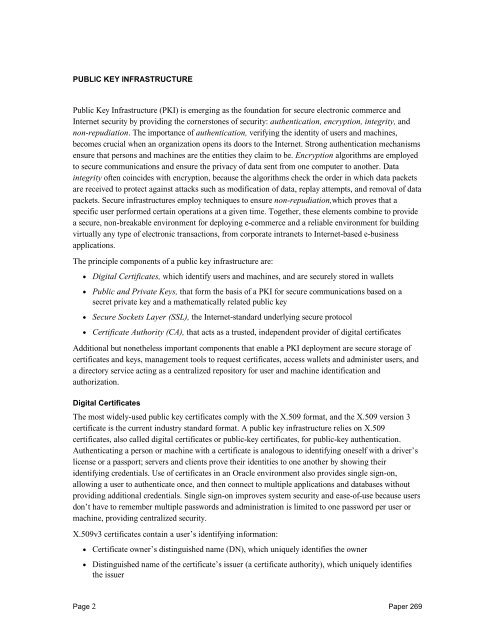Oracle 8i Security: New Features and Secure Solutions - CGISecurity
Oracle 8i Security: New Features and Secure Solutions - CGISecurity
Oracle 8i Security: New Features and Secure Solutions - CGISecurity
Create successful ePaper yourself
Turn your PDF publications into a flip-book with our unique Google optimized e-Paper software.
PUBLIC KEY INFRASTRUCTURE<br />
Public Key Infrastructure (PKI) is emerging as the foundation for secure electronic commerce <strong>and</strong><br />
Internet security by providing the cornerstones of security: authentication, encryption, integrity, <strong>and</strong><br />
non-repudiation. The importance of authentication, verifying the identity of users <strong>and</strong> machines,<br />
becomes crucial when an organization opens its doors to the Internet. Strong authentication mechanisms<br />
ensure that persons <strong>and</strong> machines are the entities they claim to be. Encryption algorithms are employed<br />
to secure communications <strong>and</strong> ensure the privacy of data sent from one computer to another. Data<br />
integrity often coincides with encryption, because the algorithms check the order in which data packets<br />
are received to protect against attacks such as modification of data, replay attempts, <strong>and</strong> removal of data<br />
packets. <strong>Secure</strong> infrastructures employ techniques to ensure non-repudiation,which proves that a<br />
specific user performed certain operations at a given time. Together, these elements combine to provide<br />
a secure, non-breakable environment for deploying e-commerce <strong>and</strong> a reliable environment for building<br />
virtually any type of electronic transactions, from corporate intranets to Internet-based e-business<br />
applications.<br />
The principle components of a public key infrastructure are:<br />
• Digital Certificates, which identify users <strong>and</strong> machines, <strong>and</strong> are securely stored in wallets<br />
• Public <strong>and</strong> Private Keys, that form the basis of a PKI for secure communications based on a<br />
secret private key <strong>and</strong> a mathematically related public key<br />
• <strong>Secure</strong> Sockets Layer (SSL), the Internet-st<strong>and</strong>ard underlying secure protocol<br />
• Certificate Authority (CA), that acts as a trusted, independent provider of digital certificates<br />
Additional but nonetheless important components that enable a PKI deployment are secure storage of<br />
certificates <strong>and</strong> keys, management tools to request certificates, access wallets <strong>and</strong> administer users, <strong>and</strong><br />
a directory service acting as a centralized repository for user <strong>and</strong> machine identification <strong>and</strong><br />
authorization.<br />
Digital Certificates<br />
The most widely-used public key certificates comply with the X.509 format, <strong>and</strong> the X.509 version 3<br />
certificate is the current industry st<strong>and</strong>ard format. A public key infrastructure relies on X.509<br />
certificates, also called digital certificates or public-key certificates, for public-key authentication.<br />
Authenticating a person or machine with a certificate is analogous to identifying oneself with a driver’s<br />
license or a passport; servers <strong>and</strong> clients prove their identities to one another by showing their<br />
identifying credentials. Use of certificates in an <strong>Oracle</strong> environment also provides single sign-on,<br />
allowing a user to authenticate once, <strong>and</strong> then connect to multiple applications <strong>and</strong> databases without<br />
providing additional credentials. Single sign-on improves system security <strong>and</strong> ease-of-use because users<br />
don’t have to remember multiple passwords <strong>and</strong> administration is limited to one password per user or<br />
machine, providing centralized security.<br />
X.509v3 certificates contain a user’s identifying information:<br />
• Certificate owner’s distinguished name (DN), which uniquely identifies the owner<br />
• Distinguished name of the certificate’s issuer (a certificate authority), which uniquely identifies<br />
the issuer<br />
Page 2 Paper 269










